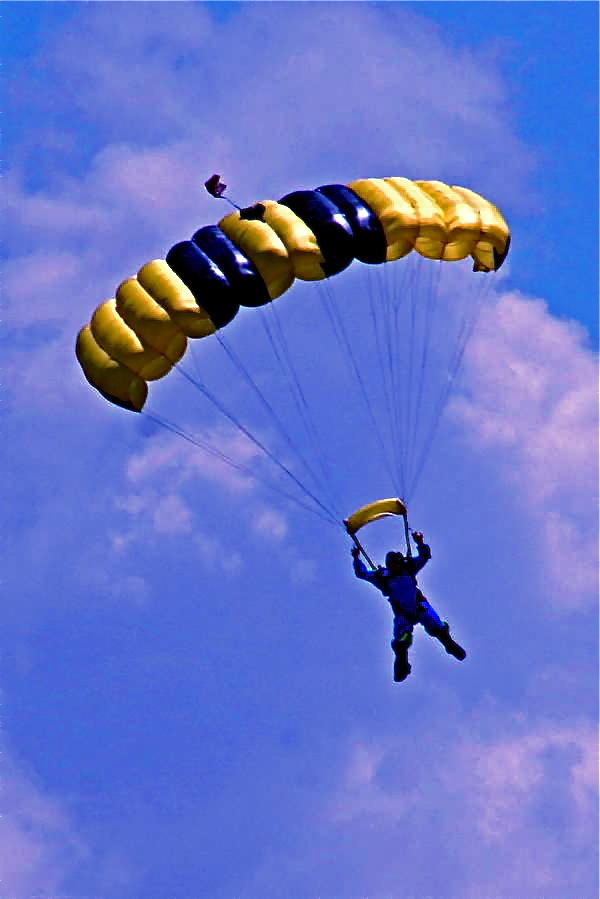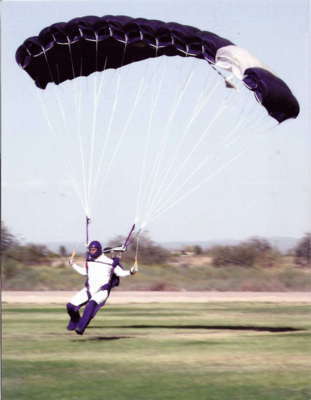Recommended Posts
Quote
Get on a canopy control course as soon as you can.
I hear Scott Miller's course is great. I plan on taking it next year.
We are all engines of karma
buzi 0
Really good flares, along with many other things come with time and practice. A video is a good idea, so is watching other people with similar canopies land. Most importantly talk to your instructor, or ask other experienced jumpers for tips at your DZ, they can sometimes see you land and will be able to give you tips. Also try to mentally visualize your landings, and at what points you will flare.
BIGUN 1,314
I agree with Skybytch. One cannot learn flaring, surge avoidance, toggle control on landing, horizon, not to horizon or canopy landing techniques over the Internet. Please get with your Instructors at your home DZ and get some dedicated 1-1 assistance.
Nobody has time to listen; because they're desperately chasing the need of being heard.
Royd 0
Reply To
--------------------------------------------------------------------------------
Get on a canopy control course as soon as you can.
--------------------------------------------------------------------------------
He concentrates on a couple of techniques per jump.
We were opening around 4500', so there was plenty of time to practise.
A lot of his basic course if just fine tuning a lot of the material that you had to learn to make your first jump.
Taking a break from weekend jumping to take the course is well worth the money.
--------------------------------------------------------------------------------
Get on a canopy control course as soon as you can.
--------------------------------------------------------------------------------
I just took it last weekend in DeLand.QuoteI hear Scott Miller's course is great. I plan on taking it next year.
He concentrates on a couple of techniques per jump.
We were opening around 4500', so there was plenty of time to practise.
A lot of his basic course if just fine tuning a lot of the material that you had to learn to make your first jump.
Taking a break from weekend jumping to take the course is well worth the money.
How much is the Deland course and how does it work?
NWFlyer 2
QuoteHow much is the Deland course and how does it work?
Check here http://www.freedomofflight.tv/public/index.php?which=canopy
I think it's $155 including five jumps (hop & pops). Weather permitting, it's a one-day class, with classroom instruction, jumps, and video debrief and more instruction between the jumps.
It's a great class, whereever you are in your jumping career. I imagine you would have to be at least cleared for solo status if you take it as a student, but when I took it there were people in the class who didn't yet have their A license.
"There is only one basic human right, the right to do as you damn well please. And with it comes the only basic human duty, the duty to take the consequences." -P.J. O'Rourke
Here is a diatribe that I have written on here before about landings. Take it for what it is worth. I have PM'd it to the dudes who have asked the questions also.
I want you to go and look at the horizon tomorrow morning. Look at it while standing flat on your feet, then look at it on your tiptoes. Notice how your sight picture changes. Now keep the sight picture of the horizon on flat feet in your mind. Your next jump should be a hop and pop fro the top. Now practice flares, and only flare as much as you need to keep the sight picture the same as when standing with flat feet. If this is too much to wrap your head around, try to feel what it is like in your harness while not giving any inputs. This is a one G (the force that gravity exerts on your body). Now feel what it is like in your harness when you are flaring. If you feel a lot of pull in your leg straps (more than one G) then you are probably climbing, and flaring too much. Your flare should induce not much more than one G on your wing loading. Another thing that I see people do wrong a lot is not flaring all the way. Go out and take a camel back full of margarita, and just watch people land all day long. I know, it is like watching golf on TV, but it can be exciting, and you can actually learn a lot. Not only should you observe what inputs they are giving to their canopies but look and see what the canopy is actually doing. You will soon learn that you can tell more of what they are doing wrong by looking at the canopy itself, and less at the person. A canopy should be flown into the wind symmetrically, and smoothly. If one part is lower than the other, it is an uneven flare. If there is a lot of flare all at once, then they were probably in corner. Learn to observe the recovery arc on the canopies. You will notice that most people are still in a dive from a front riser input when they give toggle, or rear riser input to dig themselves out. Now when you sober up from the camel Toe (I mean Camel Back) of Margarita, then go, do another hop, and pop from the top. Do a turn (it does not really matter what type you do), and LISTEN to your canopy. Actually close your eyes and listen. You will notice that your canopy will take quite awhile to recover on its own from this input. I believe the Scott Miller Course says it takes close to 10 seconds for a canopy to recover back to its own full flight from an input. Another thing you will notice will be that people do not truly fly their canopies on final approach. They tend to point it in the general direction that they want to land, and expect that the canopy will take them there. If you are not continuously flying your canopy then you are wrong. Fly that thing until you get back into the hangar and pack it. If you let the canopy do its own things it will put you into a bad situation that you may, or may not have the flying skills to get out of. Do not let yourself get into a situation that you have to pull some skills out of your ass that you may not have... Been there and done that, it is not cool. Take my word on that one.
Also please be careful on whom you take advise from. There are many self-proclaimed canopy experts out there, but that does not mean they are right. Seek professional help if you are still having problems. Sometimes on DZ.com it is the blind leading the blind, so you have to learn from who ever makes you feel the most comfortable. I hope this helps you out in some sort of way, but the biggest thing is for you to go out and keep trying. DO NOT get frustrated and quit. It will come to you some day, and then it will be as natural as breathing. Until then good luck and be careful.
Here is a post I made about two stage flares:
"I think when people are talking about staged flares they are just passing on bad information! Think of it this way. In its simplest form there are three areas to a landing.
1. Approach
2. Plane out
3. Stopping
To transition from your approach to plane out, you need to give input to the canopy whether it is toggles or rears. Now do you stop from there? NO. You have to give more input to the canopy to transition from plane out to stopping, correct? Now I'm going to introduce a little bit more of a radical concept here, so everyone take a second and catch your breath...
Let's first of all get rid of this concept of a two or three staged flare. You don't come in flare halfway, stop, and then flare the rest of the way do you? If so you are doing it wrong. Does that method work? Yes, sometimes, but we are a little more advanced than that, aren't we? I believe this concept was brought about by the old timers who were transitioning from F-111 to ZP canopies. They used this when their canopies would balloon up when they flared all the way like they were used to with their F-111's.
Let us take the three areas that I spoke of earlier and make them into just one.
1. Landing
You need to start thinking this way because, when you are transitioning to smaller faster canopy's, landing doesn't just happen when your altitude reaches zero. Many of the high speed low drag dudes here will probably agree with me that landing for them starts just after they get everything stowed away after opening. Watch them, and talk to them, and you will soon see that every maneuver they make is to set up for landing. There is really no more "Playing Around" when you get to small canopies. Now let us get back to Landing. Your approach flare and stopping should all be one smooth movement. Only flare as much as you need to maintain the altitude above the ground that you want.
Try looking at the horizon during this part of you landing. I want you to standup right now and look at a far doorknob or something out your window on the horizon. Now stand on your toes, and then back on your flat feet. Do you see the difference in your sight picture? Now how much have you actually moved? 3 to 4 inches if that.
Now that you have that mastered, think about continuing your flare only as much as you need to, so that your sight picture does not change! I told you it was going to get radical! Now that we are flying flat and level over the ground we eventually need to stop. Well just keep flaring, and maintaining your sight picture. Eventually you will have flared so much that your canopy will no longer be able to produce the amount of lift required to hold your body in the air. This is usually when you put your feet down on the ground.
I can't tell you how many people I see that don't fly their canopy to it's fullest potential, and then complain that their canopy doesn't have enough flare to support their fat ass's, and that they need to get a Velocity because it has a more powerful flare
Learn to flare your canopy all of the way. You should not have to run out your landings very much if you are flaring it correctly, even on low wind to no wind days.
If you change your thought process, and learn to fly your canopy to its fullest then you will be unstoppable!"
Here is some more specific advice. Try to keep two steps ahead of your canopy. When I say that, I mean that you should be a proactive pilot instead of a reactive pilot. Being proactive is planning ahead where you want to be over the ground at a certain altitude. It also means seeing bad situations and avoiding them. This can be as simple as watching your friends land before you and seeing their canopy's collapse because of some weird turbulence, and then not landing where they were landing. Being a reactive pilot would be seeing your friends canopy collapse and then land right were they landed and trying to deal with the turbulence. There is a certain amount of reactivity that you need to have, but thinking ahead will almost always keep you out of trouble.
If you can find a friend who is jumping a similar canopy with a similar loading, then I suggest you both do some hop and pops from the top. Practice flying in formation. Have your friend lead, and signal his or her turn direction with his legs, and just fly in formation. Just like a freefall you need to dirt dive it, and plan it out. Most importantly stick to the plan.
When you get down you will realize how much you actually had to fly the canopy to stay in formation even if you were just going straight. This is what I mean by continuously flying the canopy until you are packing it. While you are flying in this formation practice using all of your control inputs, and seeing what each one does. Have your friend fly around in full flight instead of brakes, as you both will be very tired when you get down.
The more you practice this, the closer you can get to each other and this will require much more precision flying. Get with an AFF instructor and review what to do in a wrap just in case, but the best way to not get into a wrap is to communicate and fly smoothly.
Smooth control inputs are imperative, and I want you to focus on only making smooth inputs from now on. If you are yanking and banking on your inputs, then you were flying reactively, and not thinking ahead of the canopy. Do you see how it all comes around full circle?
Let me know if any of this stuff is too nebulous for you. I hope this helps out, and please do not be afraid to ask questions. Good luck, and let me know how all of this works out for you.
Grant
I want you to go and look at the horizon tomorrow morning. Look at it while standing flat on your feet, then look at it on your tiptoes. Notice how your sight picture changes. Now keep the sight picture of the horizon on flat feet in your mind. Your next jump should be a hop and pop fro the top. Now practice flares, and only flare as much as you need to keep the sight picture the same as when standing with flat feet. If this is too much to wrap your head around, try to feel what it is like in your harness while not giving any inputs. This is a one G (the force that gravity exerts on your body). Now feel what it is like in your harness when you are flaring. If you feel a lot of pull in your leg straps (more than one G) then you are probably climbing, and flaring too much. Your flare should induce not much more than one G on your wing loading. Another thing that I see people do wrong a lot is not flaring all the way. Go out and take a camel back full of margarita, and just watch people land all day long. I know, it is like watching golf on TV, but it can be exciting, and you can actually learn a lot. Not only should you observe what inputs they are giving to their canopies but look and see what the canopy is actually doing. You will soon learn that you can tell more of what they are doing wrong by looking at the canopy itself, and less at the person. A canopy should be flown into the wind symmetrically, and smoothly. If one part is lower than the other, it is an uneven flare. If there is a lot of flare all at once, then they were probably in corner. Learn to observe the recovery arc on the canopies. You will notice that most people are still in a dive from a front riser input when they give toggle, or rear riser input to dig themselves out. Now when you sober up from the camel Toe (I mean Camel Back) of Margarita, then go, do another hop, and pop from the top. Do a turn (it does not really matter what type you do), and LISTEN to your canopy. Actually close your eyes and listen. You will notice that your canopy will take quite awhile to recover on its own from this input. I believe the Scott Miller Course says it takes close to 10 seconds for a canopy to recover back to its own full flight from an input. Another thing you will notice will be that people do not truly fly their canopies on final approach. They tend to point it in the general direction that they want to land, and expect that the canopy will take them there. If you are not continuously flying your canopy then you are wrong. Fly that thing until you get back into the hangar and pack it. If you let the canopy do its own things it will put you into a bad situation that you may, or may not have the flying skills to get out of. Do not let yourself get into a situation that you have to pull some skills out of your ass that you may not have... Been there and done that, it is not cool. Take my word on that one.
Also please be careful on whom you take advise from. There are many self-proclaimed canopy experts out there, but that does not mean they are right. Seek professional help if you are still having problems. Sometimes on DZ.com it is the blind leading the blind, so you have to learn from who ever makes you feel the most comfortable. I hope this helps you out in some sort of way, but the biggest thing is for you to go out and keep trying. DO NOT get frustrated and quit. It will come to you some day, and then it will be as natural as breathing. Until then good luck and be careful.
Here is a post I made about two stage flares:
"I think when people are talking about staged flares they are just passing on bad information! Think of it this way. In its simplest form there are three areas to a landing.
1. Approach
2. Plane out
3. Stopping
To transition from your approach to plane out, you need to give input to the canopy whether it is toggles or rears. Now do you stop from there? NO. You have to give more input to the canopy to transition from plane out to stopping, correct? Now I'm going to introduce a little bit more of a radical concept here, so everyone take a second and catch your breath...
Let's first of all get rid of this concept of a two or three staged flare. You don't come in flare halfway, stop, and then flare the rest of the way do you? If so you are doing it wrong. Does that method work? Yes, sometimes, but we are a little more advanced than that, aren't we? I believe this concept was brought about by the old timers who were transitioning from F-111 to ZP canopies. They used this when their canopies would balloon up when they flared all the way like they were used to with their F-111's.
Let us take the three areas that I spoke of earlier and make them into just one.
1. Landing
You need to start thinking this way because, when you are transitioning to smaller faster canopy's, landing doesn't just happen when your altitude reaches zero. Many of the high speed low drag dudes here will probably agree with me that landing for them starts just after they get everything stowed away after opening. Watch them, and talk to them, and you will soon see that every maneuver they make is to set up for landing. There is really no more "Playing Around" when you get to small canopies. Now let us get back to Landing. Your approach flare and stopping should all be one smooth movement. Only flare as much as you need to maintain the altitude above the ground that you want.
Try looking at the horizon during this part of you landing. I want you to standup right now and look at a far doorknob or something out your window on the horizon. Now stand on your toes, and then back on your flat feet. Do you see the difference in your sight picture? Now how much have you actually moved? 3 to 4 inches if that.
Now that you have that mastered, think about continuing your flare only as much as you need to, so that your sight picture does not change! I told you it was going to get radical! Now that we are flying flat and level over the ground we eventually need to stop. Well just keep flaring, and maintaining your sight picture. Eventually you will have flared so much that your canopy will no longer be able to produce the amount of lift required to hold your body in the air. This is usually when you put your feet down on the ground.
I can't tell you how many people I see that don't fly their canopy to it's fullest potential, and then complain that their canopy doesn't have enough flare to support their fat ass's, and that they need to get a Velocity because it has a more powerful flare
Learn to flare your canopy all of the way. You should not have to run out your landings very much if you are flaring it correctly, even on low wind to no wind days.
If you change your thought process, and learn to fly your canopy to its fullest then you will be unstoppable!"
Here is some more specific advice. Try to keep two steps ahead of your canopy. When I say that, I mean that you should be a proactive pilot instead of a reactive pilot. Being proactive is planning ahead where you want to be over the ground at a certain altitude. It also means seeing bad situations and avoiding them. This can be as simple as watching your friends land before you and seeing their canopy's collapse because of some weird turbulence, and then not landing where they were landing. Being a reactive pilot would be seeing your friends canopy collapse and then land right were they landed and trying to deal with the turbulence. There is a certain amount of reactivity that you need to have, but thinking ahead will almost always keep you out of trouble.
If you can find a friend who is jumping a similar canopy with a similar loading, then I suggest you both do some hop and pops from the top. Practice flying in formation. Have your friend lead, and signal his or her turn direction with his legs, and just fly in formation. Just like a freefall you need to dirt dive it, and plan it out. Most importantly stick to the plan.
When you get down you will realize how much you actually had to fly the canopy to stay in formation even if you were just going straight. This is what I mean by continuously flying the canopy until you are packing it. While you are flying in this formation practice using all of your control inputs, and seeing what each one does. Have your friend fly around in full flight instead of brakes, as you both will be very tired when you get down.
The more you practice this, the closer you can get to each other and this will require much more precision flying. Get with an AFF instructor and review what to do in a wrap just in case, but the best way to not get into a wrap is to communicate and fly smoothly.
Smooth control inputs are imperative, and I want you to focus on only making smooth inputs from now on. If you are yanking and banking on your inputs, then you were flying reactively, and not thinking ahead of the canopy. Do you see how it all comes around full circle?
Let me know if any of this stuff is too nebulous for you. I hope this helps out, and please do not be afraid to ask questions. Good luck, and let me know how all of this works out for you.
Grant
This was an excellent write-up. Thanks! 
We are all engines of karma
Remster 30
Nice write up... You should submit it to the article section.
Remster
I don't know if you can tell but I went to the Mark Shimmel school of speling. hahahaha
That stuff may be a little advanced for someone off of AFF but the concepts are there for them to start comprehending now. I havn't thought about submitting it as I don't want to come accross as a canopy know it all type. I would have to clean it up a little (speling) too. Thanks though, and I hope it helps people out.
That stuff may be a little advanced for someone off of AFF but the concepts are there for them to start comprehending now. I havn't thought about submitting it as I don't want to come accross as a canopy know it all type. I would have to clean it up a little (speling) too. Thanks though, and I hope it helps people out.
DustyP 0
Thanks For Posting That!
That's the kind of feedback i was looking for!
To bad you can't roll to the DZ with me!! lol
Let you know how the next landings go!
Peace,
DustyP
That's the kind of feedback i was looking for!
To bad you can't roll to the DZ with me!! lol
Let you know how the next landings go!
Peace,
DustyP
.
Jaden 0
Excellent info…Thanks!
I think many people who have problems with canopy flight are stuck thinking two dimensionally. They think like they are driving a car. Forward (fast or slow), right and left. With a canoppy you have that up and down aspect to start to think about. Most people get in trouble on their canopy because they do not think one or two steps ahead of where they are at that actuall moment in time and space. I found out that my canopy performance got astronomically better when I started to plan my decents out just like a dirt dive. The I became a proactive pilot instead of a reactive pilot. Sure each flight was a little different and things change (wind strength and direction, amount of traffic, landing patterns and what not), but the more that I planned things out and flew the same pattern the better I became. I think it was because I was eliminating as many variables as possible by doing the same thing time after time. Yea it sounds borring, but I rather enjoyed being able to be at the relatively same place over the ground at the same altitude time after time after time. This allowed my to focus on the aspects of my turn and what the wind was doing to my turn. I'm not saying that you need to bust out 450's and that this technique is only for swooping because it isn't. It doesn't matter what turn you are doing or if you are swooping or doing classic accuracy (if you really want a challenge then try classic acc... It looks gay, but it is actually really freaking fun and challenging. Style and free flying is still gay though) doing the same pattern every time will make you more consistant and accurate. Accuracy is very important in this sport. If you are swooping or aspire to swoop then you need to learn accuracy. It is one third of the Pro Swooping Tour Make up, and you have to hit gates every time or your run doesn't count. If you want to jump into stadiums later on in life then accuracy is very important to you. If you are still having problems then get some qualified canopy coaching. Listen to your instructors, and don't let your canopy fly you.






I think its a crutch for students (like 'hands together during flare' etc.) to stop them from looking straight down at their feet and getting ground rush.
I just look at where I'm going.
Share this post
Link to post
Share on other sites